
Several problems…
- High Inflation across the world…
- Central Banks increasing interest rates and tightening liquidity…
- Russia-Ukraine Crisis…
- High Crude Oil Prices…
- China Lockdowns and Supply Chain Constraints…
- High FII outflows from Indian Equities… etc.
Indian Equity Markets are down 13%…
Eavesdropping into your mind voice…
If my guess is right, this is exactly what is going on in your mind…
There are several problems leading to the current fall. A lot of experts are getting worried and are warning for tough times ahead. There is a lot of uncertainty in the near term, and it looks like things will get worse before they improve.
Let me temporarily take my money out of equities to prevent any further damage.
While I am positive on equities over the long term, I will wait for the markets to fall more and enter back at lower levels when I see the first signs of the current situation improving (read as some positive news on the war, inflation, US Fed Rate hikes, FII outflows etc). This way I can side-step the fall and enter back at lower levels before the market starts to recover again.
While your plan looks perfectly logical, let us hear what the legendary investors have to say about this…
“The idea that a bell rings to signal when investors should get into or out of the market is simply not credible. After nearly 50 years in this business, I do not know of anybody who has done it successfully and consistently.” – Jack Bogle
“Short-term market forecasts are poison and should be kept locked up in a safe place, away from children and also from grown-ups who behave in the market like children.” – Warren Buffet
“People who exit the stock market to avoid a decline are odds-on favorites to miss the next rally.
If timing the market is such a great strategy, why haven’t we seen the names of any market timers at the top of the Forbes list of richest Americans?” – Peter Lynch
“In all my 55 years on Wall Street, before I retired to do something vastly more important, I was never able to say when the market would go up or down. Nor was I able to find anybody on Earth whose opinion I would value on the subject of when it would go up and down.” – John Templeton
“Most people who have been really successful in the securities markets say the same thing — that they’re not smart enough to get into the market and out of it. So they tend to remain more or less in the market at all times.” – Walter Schloss
Oops!
All legendary investors seem to be against your idea of moving out to avoid the fall and entering back at lower levels.
But why do they think ‘Exit Now and Enter Back At Lower Levels’ is a bad strategy?
Enter the 5 Counter-Intuitive Traps of a Falling Market!
When we studied past bear markets in India and across the globe, we found that there are 5 counterintuitive patterns (read as traps) that occur during a market fall. These counter-intuitive patterns make it insanely difficult to enter back into the markets at lower levels after you have sold out.
- To time the entry back is difficult because history shows us that stock markets typically hit their bottom before the worst news arrives. The recent Covid 2020 crash was a classic case where the Indian markets rallied by 40% before the actual covid cases peaked in the first wave. This is a pattern seen across most bear markets in India and globally.
- There are a lot of false rallies in the middle of a market fall. It’s difficult to distinguish between the real recovery and the false rally.
- Waiting for a few months (say 3-6 months) to confirm a recovery also does not work well as most of the times the initial recovery rally is extremely fast. (sample this – Sensex rallied 85% in 3 months during the 2009 recovery)
- Once we miss the bottom, we are also psychologically anchored to the bottom levels and find it difficult to enter back at higher levels
- Even the best market experts can’t exactly predict the timing of market recovery on a consistent basis as there are a lot of evolving factors that impact the markets in the short run and it’s difficult to predict how millions of investors are going to react to that.
Overall, while it’s easy to move out, these 5 counterintuitive patterns along with the fact that no one has predicted short term market movements consistently make it extremely difficult to time your entry back if you exit now.
This is why most of the legendary proven investors advice against timing the market (read as attempting to exit in the middle of a fall and entering back at lower levels).
Does that mean even if the market falls I should take up all the pain?
The market has fallen 15-20% doesn’t always mean it will fall further…
The last 42+ years history of Sensex, has a stark reminder for all of us –
Indian Equity Markets Experience a Temporary Fall EVERY YEAR!
In fact, a 10-20% fall is almost a given every year. There were only 3 out of 42 years (represented by the yellow bars) where the intra-year fall was less than 10%.
Let us put this in context with the current fall…
It’s ~13% Fall from the peak.
There you go. When viewed from a historical lens, the recent fall is perfectly normal and there is nothing to be surprised!
And just because the market has fallen 15-20% doesn’t imply that it will have to fall further.
Sample this. Despite the intra-year falls every year, 3 out of 4 years ended with positive returns.
In fact, even bull markets had several intermittent falls…
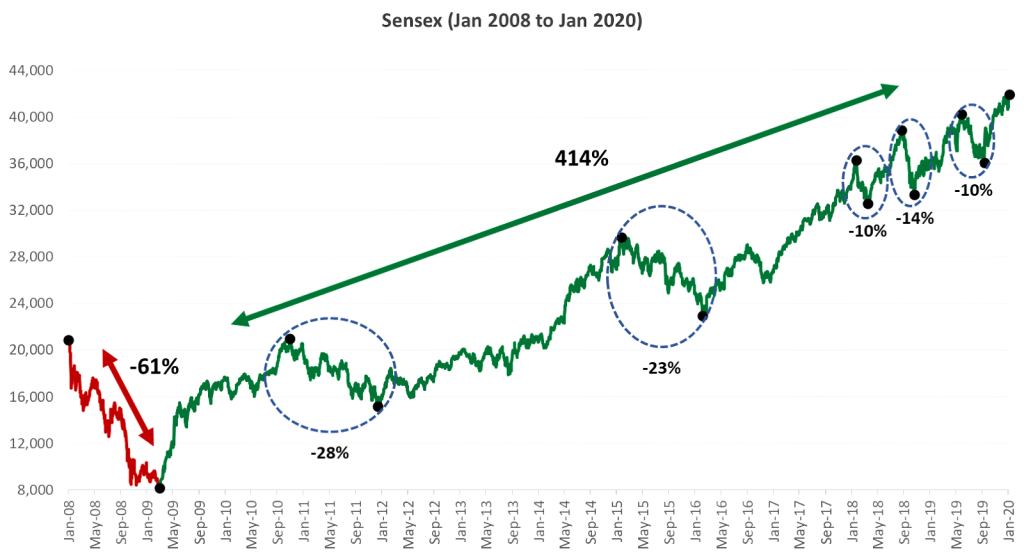
But what about the scary large falls (30-60%) that happen (think covid fall, subprime crisis etc)?
Let us again take the help of history to form a view on how common it is for the market to have a temporary but large scary fall of more than 30%.
As seen above, a sharp temporary fall of 30-60% is a lot less frequent than the 10-20% fall. They usually occur once every 7-10 years.
Now that leads to the next important question.
Since every large decline will eventually have to start with a small decline, how do we differentiate if the current fall is a normal 10-20% fall or the start of a large fall?
This is where we take the help of market cycles. A market cycle can be viewed in three phases – Bull, Bubble and Bear Phase.
Usually, when in a Bubble Phase, the odds of a 10-20% correction converting into a large fall is very high.
While we can’t precisely predict a large fall, if we are in a bubble phase we may need to be more careful and reduce equity allocation. Think of it as an overspeeding vehicle. While you can’t predict if this vehicle will definitely meet with an accident, the odds of an accident are high if met with some unexpected events (say a pothole, some animal suddenly crossing the road, another driver taking a sudden turn without signalling etc).
A Bubble as per our framework is usually characterized by
- Very Expensive Valuations (measured by FundsIndia Valuemeter)
- Late Stages of Earnings Cycle
- Euphoric Sentiments (measured via our FINAL Framework – Flows, IPOs, Surge in New Investors, Sharp Acceleration in Price, Leverage)
We evaluate the above using our Three Signal Framework and Bubble Market Indicator (built based on 30+ indicators)
Are we currently in a Bubble as per our framework?
Here is how our framework evaluates the current markets
1. Valuations are in the Neutral Zone post the correction (was in the Expensive Zone till Jan-22)
2. Earnings Growth – We are in the Early Stages of Earnings Growth Cycle – High Odds of Strong Earnings Growth in the next 5-7 years (refer to our monthly report FundsIndia Viewpoint for a detailed rationale on the drivers)
3. Sentiment: NEUTRAL
Strong FII Outflows 12M FII flows turning negative is a contra-positive indicator and has historically led to strong equity returns over the next 2-3 years (as FII flows eventually come back in the subsequent periods)
Overall, our framework suggests that we are not in an extreme bubble-like market scenario. In other words, the likelihood of the current fall converting into a large fall (>30%) is very low.
What if despite us not seeing a bubble at the current juncture the market corrects more than 20% (as there is still a low probability)?
While the odds of a large fall are very low, there is still a small probability that this becomes a large fall. If we get a large fall, historically we have seen that markets have eventually recovered and continued to grow (mirroring earnings growth over the long term).
Since we expect earnings growth to remain strong over the next 5-7 years, the current valuations are reasonable and the FII outflows historically indicate strong returns over next 2-3 years, any further fall is a great opportunity to add money into equities.
Also history shows that despite several crisis, Indian Equity Markets have always recovered and gone up over the long run.
Every crisis in the past has been followed by a recovery and further upside.
This simple insight can be converted into our advantage if we are able to deploy more money into equities from our debt portion at lower market levels during a sharp market fall.
How do you put all this into action?
This can be put into action via the ‘CRISIS’ plan.
Pre-decide a portion of your debt allocation (say Y) to be deployed into equities if in case market corrects further
- If Sensex Falls by ~20% (i.e Sensex at 50,000) – Move 20% of Y into equities
- If Sensex Falls by ~30% (i.e Sensex at 44,000) – Move 30% of Y into equities
- If Sensex Falls by ~40% (i.e Sensex at 38,000) – Move 40% of Y into equities
- If Sensex Falls by ~50% (i.e Sensex at 32,000) – Move remaining portion from Y into equities
*this is a rough plan and can be customised based on your personal circumstances, goals and risk profile
Now because you know the logical reasons as to why you shouldn’t step out in the middle of a market fall and you also have a pre-decided plan to deploy more money if the market falls further, this doesn’t mean resisting the urge to sell out will be easy.
The real challenge comes in the form of psychological mind games.
Warning: If the fall exceeds 30%, your patience and conviction will be tested
Here is how your patience and conviction will be tested across different phases of a market fall
When the market is down 15-20%, the mind games begin…
PHASE 1: Increasing Worry – Several “What ifs”
- What if markets fall further?
- Extrapolation of current bad news
- Experts warn you that things are set to become worse
- Media Articles scare you
- What if Indian Equity Markets become like Japanese Equity Markets (didn’t recover from the bear market for decades)
- Everyone seems to be selling out – anxiety and panic in others will also impact you
- Your Personal Circumstances may change – job loss, pay cut, health issue, sudden need of money etc
PHASE 2: Your Intuition shouts “Do something before it gets worse”
- Market falls induce panic and our time horizons shorten dramatically. Every day you delay your decision your portfolio seems to lose more money.
- Pressure to decide immediately before it is too late – being a long-term investor gets even more difficult.
- Urge to Exit Now and Side-Step the Fall. You think you can enter back at lower levels when the coast is clear
PHASE 3: You Resist the Urge (or you PANIC and get out)
- You remember the 5 counterintuitive traps
- You remind yourself of the advice from major investors
- You stick to your belief – Equity Markets do well over long term. Markets cannot be timed.
PHASE 4: Oops! Market Falls Further by 5-10%.
PHASE 5: This Fall Will Seem Predictable – ‘I Knew It All Along’ syndrome
- In hindsight, it will seem obvious that this fall was coming – the red flags were everywhere and this fall could have been predicted
- In fact, you had predicted this fall a few weeks back
- You will ignore all periods where there were red flags but market didn’t fall
- This is commonly referred to as Hindsight Bias or the I-Knew-It-All-Along syndrome
PHASE 6: REGRET – “If only you had sold…”
- This point in a falling market where your intuition comes right in the short term is the most dangerous phase.
- You regret not having listened to your intuition. “If only you had sold earlier”…
PHASE 7: You are Frustrated
- First the returns dropped to lower than FD returns
- Then all the gains vanished
- Now the portfolio value is lower than your invested amount
- Several Years of Gains got erased in the last few months
- Even SIP returns are very poor
PHASE 8: You Start Doubting Your Plan and Belief
- Should you still believe in Equities?
- What if this plan is not working anymore?
- What if this time it’s different?
This is followed by Phase 1 again and the cycle repeats. The cycle usually continues till you panic and end up exiting equities in Phase 4.
Simply put – Bear markets can be psychologically draining.
This is why though you may understand the logic of why you shouldn’t sell out in the middle of a market fall, behaviorally sticking to the plan is still going to be extremely difficult.
No wonder, Bear markets are the ultimate behavioral test for investors.
Those who survive the test, will eventually be rewarded with superior long term returns.
As the cliche goes – it’s simple but not easy!
Summing it up
- Should you Exit Now and Enter Later?
- Given the recent market fall and several uncertainties, it is natural for a lot of us to extrapolate the current fall and think that the fall will continue. There is a strong temptation to exit equities now with the intent of entering back later at lower levels.
- Given the recent market fall and several uncertainties, it is natural for a lot of us to extrapolate the current fall and think that the fall will continue. There is a strong temptation to exit equities now with the intent of entering back later at lower levels.
- Great Investors warn against this
- Why? Mind the 5 Counterintuitive Traps
- 10-20% falls are regular while 30-60% falls happen once every 7-10 years
- How do we know if this is a 10-20% fall or the start of a larger fall?
- Three Phases of Market Cycle – Bull, Bubble, Bear
- High Chances of a 10-20% fall converting into a large fall when we are in the Bubble Phase
- Are we in a bubble?
- We don’t see any major signs of a bubble
- Low likelihood of current fall turning into a large fall (30-60%)
- Where are we in the market cycle?
- We are at Neutral Valuations + Early Stage of Earnings Cycle + Neutral Sentiments (Sharp FII outflows historically indicate strong returns over next 2-3 years)
- Any further fall is a great opportunity to add money into equities
- What if the market falls further?
- Activate the CRISIS Plan if markets cut 20% fall from previous peak
- Activate the CRISIS Plan if markets cut 20% fall from previous peak
- Warning: Your patience and conviction will be tested if the fall exceeds 30%. Bear markets can be psychologically draining.
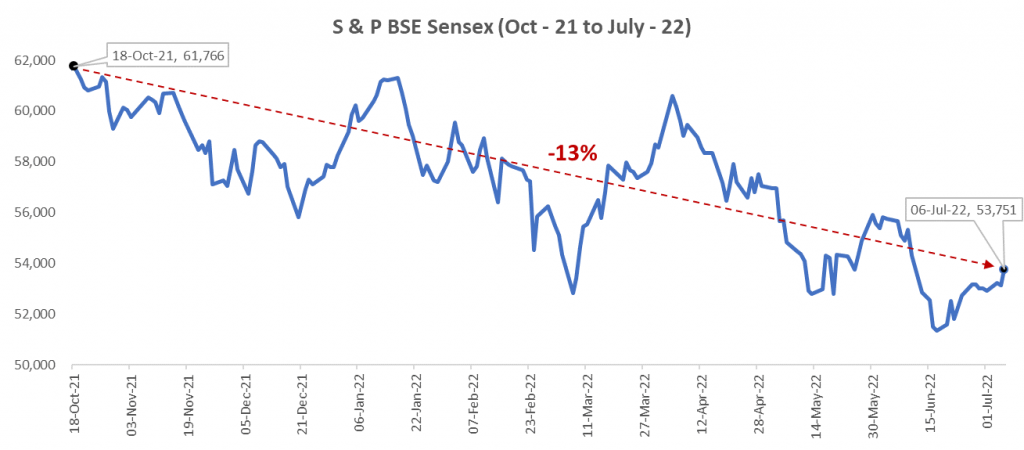
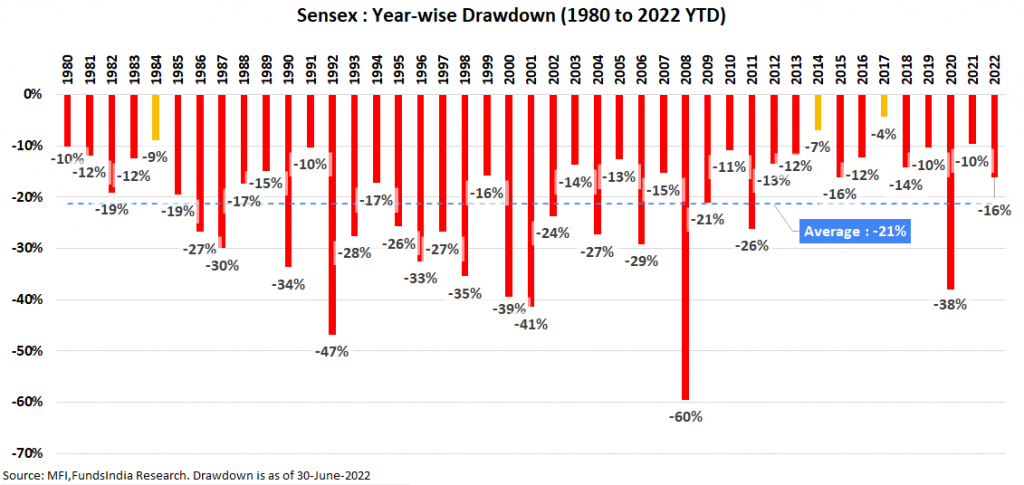

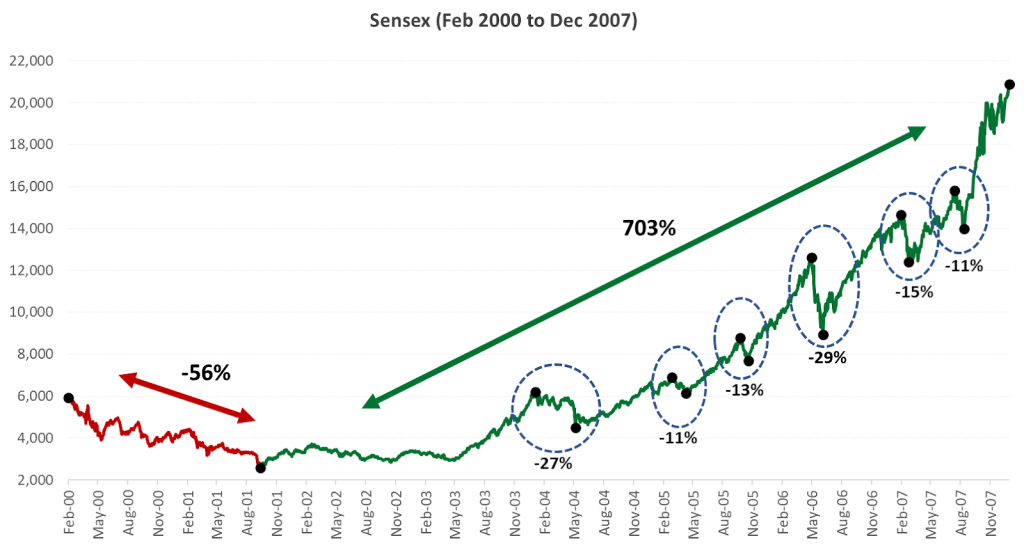


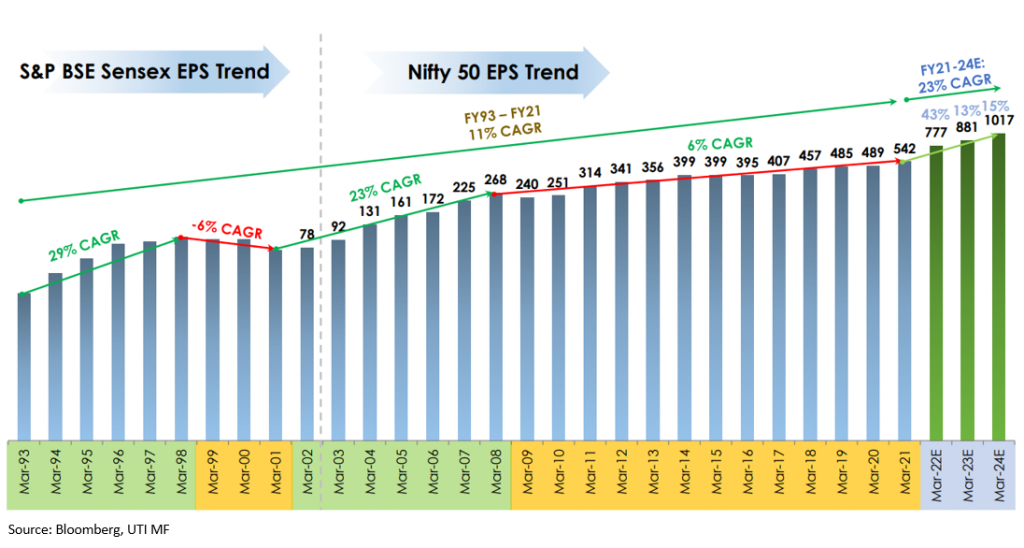

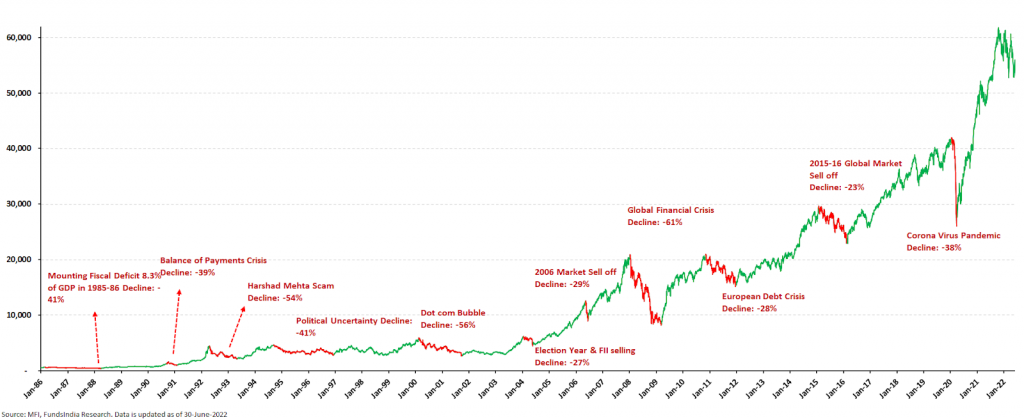








I really did not find article like this. it is all hard work and experience put into article with very well depth explained. i appreciate your hard work and dedication.
Interesting and insightful article. Did you also see if there were any economic or political factors around the same time as market declines?
Thanks a lot for your kind words. Each and every time there was a new reason/problem and the markets usually tend to recover in the middle of bad news or much ahead of the actual economic recovery.
Thanks a lot for your kind words. Each and every time there was a new reason/problem and the markets usually tend to recover in the middle of bad news or much ahead of the actual economic recovery.